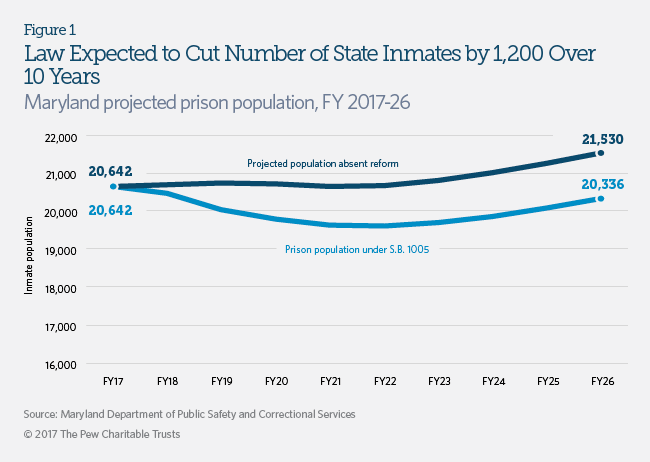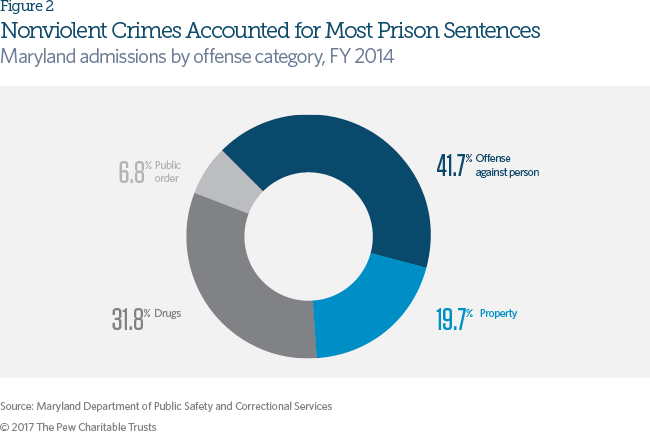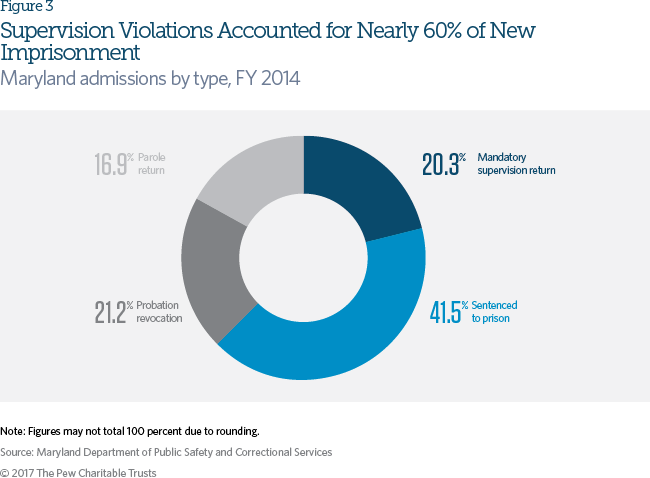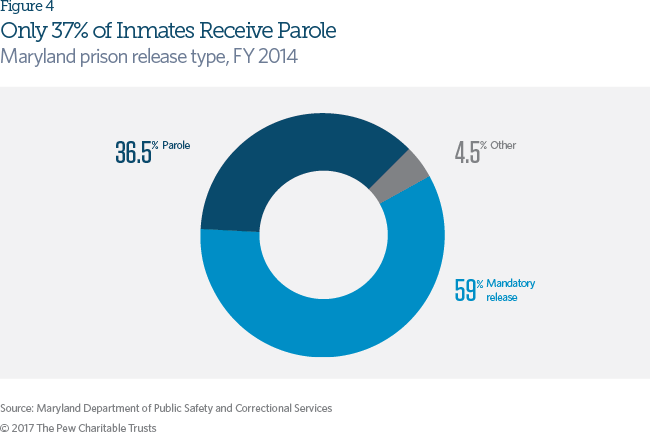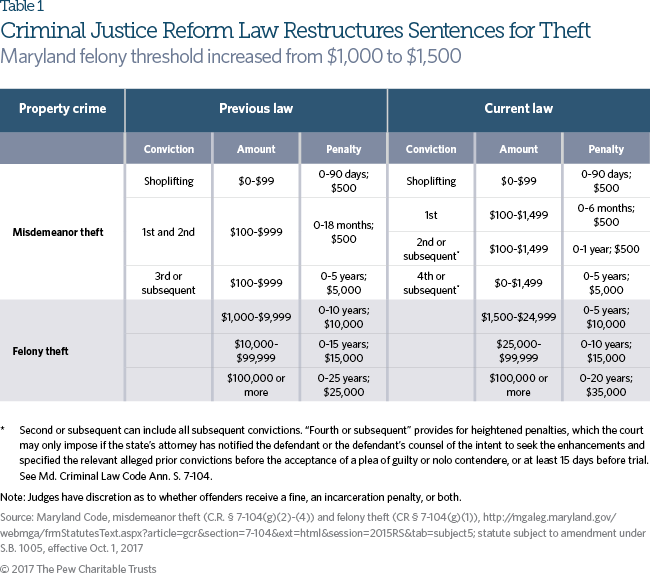Maryland’s 2016 Criminal Justice Reform
Overview
On May 19, 2016, Maryland Governor Larry Hogan (R) signed into law S.B. 1005, the Justice Reinvestment Act, which advances research-based sentencing and corrections policies. Developed by the bipartisan Justice Reinvestment Coordinating Council and passed unanimously in the Senate and with strong support in the House of Delegates, the bill is projected to cut the state’s prison population by almost 1,200 inmates and save an estimated $80.5 million over 10 years.
Highlights
Problem
Maryland’s incarceration and crime rates declined over the past decade, but the state still imprisons more than 20,000 offenders at an inflation-adjusted cost of $1.3 billion annually, up 10 percent from 2006. State policymakers, concerned about the public safety return on those investments, undertook a study of the corrections system.
Findings
The Justice Reinvestment Coordinating Council reviewed prison admissions, sentence lengths, release policies, and research on what works to reduce recidivism. It found that nonviolent offenders made up almost 60 percent of new prison entries in 2014 and that 58 percent of admissions stemmed from probation or parole violations rather than new convictions. The council also determined that inmates were spending 23 percent more time behind bars than a decade before, driven by a 25 percent increase in the average sentence length. Finally, the council found that only 37 percent of those released from prison were paroled, having served nine months past their parole eligibility, on average.
Reforms
The council developed 19 recommendations to prioritize prison space for violent offenders, strengthen parole and probation, improve release and re-entry practices, support corrections systems, and ensure oversight and accountability. Proposed reforms included raising the threshold for felony theft; revising drug penalties; and creating swift, certain, and proportional sanctions for technical violations of supervision.
Impact
State officials projected that over 10 years, the council’s recommendations would avert an anticipated 4 percent prison growth and reduce the prison population by nearly 1,200 inmates (see Figure 1), saving Maryland taxpayers $80.5 million. The law requires that a portion of the savings be used to fund grants for community-based recidivism reduction programs. The fiscal year 2017 budget also included $3 million for treatment of substance use disorders.
Throughout its work, the council focused on how to treat offenders suffering from substance abuse or mental health problems and explored re-entry programs that could help them become contributing members of their communities once they return home.—Governor Larry Hogan (R), Dec. 17, 2015
Justice Reinvestment Coordinating Council
In April 2015, Gov. Hogan; Senate President Thomas V. Mike Miller Jr. (D); House Speaker Michael E. Busch (D); Mary Ellen Barbera, chief judge of the Maryland Court of Appeals; and Attorney General Brian E. Frosh (D) charged the bipartisan, interbranch council with “using a data-driven approach to develop a statewide framework of sentencing and corrections policies to further reduce the State’s incarcerated population, reduce spending on corrections, and reinvest in strategies to increase public safety and reduce recidivism.”1
The council included criminal justice stakeholders representing the judiciary, the legislature, law enforcement, community-based programs, the prosecutorial and defense bars, and corrections agencies. From June to December 2015, the group conducted a comprehensive analysis of the state’s sentencing and community supervision data, assessed current policies, evaluated best practices in other states, and developed recommendations.
To identify priority issues and key reforms, the council held four public hearings around the state and two roundtable discussions with victims, victim advocates, and survivors. After receiving input from the public and assessing statewide data, the council developed policy recommendations and submitted them to the governor and General Assembly for consideration during the 2016 session.
The Pew Charitable Trusts and its partner, the Crime and Justice Institute at CRJ, provided technical assistance to the council, including analyzing Maryland’s sentencing and corrections data and systems, developing policy options, and educating the public and policymakers about the recommendations. This assistance was administered as part of the Justice Reinvestment Initiative, a public-private partnership between Pew and the U.S. Department of Justice’s Bureau of Justice Assistance.
We both believe strongly in justice and public safety, and we want the best for Maryland citizens. It is these common beliefs that bring us together now to back the Justice Reinvestment Act (S.B. 1005/H.B. 1312), a data-driven, evidence-based policy package, which we are proud to have helped develop.—joint statement by Justice Reinvestment Coordinating Council members Scott D. Shellenberger (D), Baltimore County state’s attorney, and state Public Defender Paul B. DeWolfe, Feb. 29, 2016
Key findings
The council identified six major factors that fueled prison growth in Maryland.
1. Most prison admissions were for nonviolent offenses.
In fiscal 2014, nonviolent convictions comprised 58 percent of all prison admissions, including the most common offense for which a prison sentence was issued—possession with intent to distribute narcotics—as well as five of the top 10 offenses earning a prison term. (See Figure 2.) Despite an overall drop in prison sentences for drug offenses from 2005-14, admissions for other nonviolent crimes had not declined as much or, in some cases, had increased. For example, felony theft admissions—one of the 10 most common—rose 8 percent.
2. Admissions for revocations of supervision outnumbered those for newly sentenced prisoners.
Nearly 60 percent of those sentenced to prison in 2014 were behind bars for breaking the rules of their community supervision. (See Figure 3.) Many of these probation and parole returns to prison were for technical violations, such as failing a drug test, missing a meeting, or being arrested for—but not convicted of—a new crime. In fiscal 2014, technical violations accounted for more than 70 percent of parole and mandatory supervision returns to prison and over 40 percent of probation revocations.
3. Sentence lengths and time served increased.
From 2005-14, initial sentences issued by judges and time served by offenders increased across all offense types. The average sentences for new prisoners and for revoked probationers rose 25 and 29 percent, respectively. Driven by a lengthening of sentences, the amount of time spent behind bars went up by an average of 23 percent, or 6.7 months. Time served for newly sentenced prisoners rose 30 percent, and for those incarcerated because of probation revocations, it increased by 25 percent. In addition, property offenders—another nonviolent category of prisoners—served 13 percent longer than a decade ago.
4. Suspended sentences grew.
In Maryland, probationers receive suspended sentences in lieu of or in addition to a period of incarceration. Over the past 10 years, the length of the average suspended sentence rose 30 percent. Those who received a prison and a suspended sentence saw increases in the length of both, with prison time up 25 percent and suspended terms rising 58 percent, substantially extending the total time served in the corrections system.
Time and again, we see families struggling to survive when loved ones are locked up. When finally released, they struggle to secure and maintain a stable job with a criminal record. The message is the same over and over again: Overreliance on incarceration is not working.—Caryn York, Justice Reinvestment Coordinating Council member and senior policy advocate for Job Opportunities Task Force, in the Maryland Reporter, April 9, 2016
5. Only about a third of inmates were paroled, and those who were faced significant delays before release.
Just 37 percent of inmates were released on parole in fiscal 2014 (see Figure 4)—though that was an increase from 30 percent in fiscal 2005—and offenders who were granted parole served an average of nine months past their eligibility date. From 2005-14, drug offenders were most likely to be paroled, with 56 percent of those released put on parole, compared with less than half of all other nonviolent releases.
In general, nonviolent offenders are eligible for parole after serving 25 percent of their sentences; violent offenders must serve at least 50 percent. The council found, however, that nonviolent parolees served around 40 percent of their sentences before being released, which is a longer delay between eligibility and release than that of violent parolees, many of whom were released soon after serving 50 percent of their sentences.
6. Imprisonment increased over alternative sanctions.
The council found that from 2005-14, for cases in which sentencing guidelines were applied and judges reported the results, courts were more likely to choose prison over other sentencing options—regardless of criminal history categories.2 In fiscal 2014, drug offenders were the least likely to be incarcerated; even so, they were sentenced to jail or prison 67 percent of the time. The remaining nonviolent offenders were incarcerated 76 percent of the time.
The increased admissions and length of stay trends contravene research demonstrating that alternative sanctions, such as probation, are as effective at reducing recidivism as incarceration and that longer prison terms do not reduce recidivism more than shorter ones.3
Legislative reform package
In December 2015, the council voted unanimously to forward 19 policy recommendations to state leaders. It projected that those policies together would reduce the state’s prison population 14 percent—to 17,600—by 2026 and save $247 million over the next decade. The General Assembly adopted many of the recommendations in S.B. 1005, which lowered the estimated savings to $80.5 million over 10 years. The bill passed unanimously in the Senate and by a vote of 123-18 in the House, with strong bipartisan support. Gov. Hogan signed the bill into law May 19, 2016.
The final bill included changes to mandatory minimum drug penalties, caps on the prison sentences that can be imposed for technical violations of supervision, and an expansion of earned time and parole practices. Lawmakers chose to partially implement the council’s recommendation to create an administrative parole process for nonviolent offenders, applying the policy only to certain low-level offenses. The full recommendation was to allow presumptive release for a wider pool of nonviolent inmates who had successfully completed their case plans, had committed no serious infractions, and were not subject to a victim-initiated parole hearing. In addition, lawmakers rejected a call for specific limitations to revocation sentences and modified parole eligibility for subsequent drug distribution offenses.
The law is organized around five primary goals.
1. Prioritize prison space for serious and violent offenders.
Research shows that prison is often not the best or most cost-effective method for keeping the public safe and that for certain offenders, longer prison sentences can actually increase recidivism.4 Maryland’s legislative package draws on this research, prioritizing the state’s prison space for serious and violent offenders. The law:
- Aligns penalties for drug offenders with research on effective practices.
- Lowers penalties for drug possession and increases access to residential drug treatment.
- Allows the courts to order pre-sentencing drug and mental health assessments to identify sentencing and treatment needs.
- Eliminates the disparity in sentencing for crack and powder cocaine offenses.
- Removes mandatory minimum enhancements for repeat, lower-level commercial drug offenders.
- Focuses mandatory minimums on high-level drug dealers.
- Allows Maryland’s “safety valve” (which enables judges to sentence below mandatory minimum levels if certain conditions are met) to be applied retroactively, permitting inmates serving mandatory minimums for drug offenses to apply to have their sentences reviewed. The provision also shifts to prosecutors the burden to show that keeping the mandatory minimum sentence in place would not result in a substantial injustice to the defendant and is necessary to protect public safety.
- Removes mandatory minimums for commercial drug offenders, excluding volume dealers.
- Adjusts penalties for property offenders.
- Raises the felony theft threshold from $1,000 to $1,500 and establishes a minimum of $100 for misdemeanor theft.
- Lowers graduated felony theft penalties. (See Table 1.)
- Expands in-prison “time credits” or diminution credits.
- Raises the amount of diminution credits (which allow for sentence reductions) permitted to most commercial drug offenders from five days a month to 10. This is the same amount already allowed for other nonviolent offenders.
- Expands the list of education programs through which an offender can qualify to earn five days of diminution credits to include workforce development, cognitive behavioral therapy, and substance use disorder therapy.
- Increases from 10 days a month to 20 the amount of credits inmates can earn through participation in special projects such as recidivism-reduction programs; this excludes those convicted of violent crimes, sexual offenses requiring registration, or high-volume drug offenses.
- In total, inmates may earn up to 30 days per month in diminution credits (moving the overall cap from 20 days to 30) if they continue to participate in required programs. This excludes inmates convicted of sex offenses, violent crimes, or high-volume drug offenses, who can instead earn a maximum of 20 days a month, according to specific guidelines based on offense type.
- Expands diminution credits in local detention centers to mirror state-level credits (raising the limit from five days a month to 10).
2. Enhance community supervision.
Probation and parole are important tools in reducing recidivism. To ensure targeted and effective supervision that is backed by research and to integrate evidence-based practices, the law:
- Requires the use of a validated risk and needs assessment tool.
- Requires the Division of Parole and Probation to assess every person under supervision, using a risk and needs tool to help focus attention on offenders who pose the highest risk of reoffending, determine an appropriate supervision level, and craft an individualized case plan for those determined to be of moderate or high risk.
- Implements swift, certain, and proportional sanctions and incentives.
- Requires the division to create an evidence-based matrix to guide supervision, including rewards for positive behavior and escalating sanctions for noncompliance.
- Limits the amount of incarceration time a judge or the parole board can impose for a technical violation of supervision rules to 15 days for the first breach, 30 days for the second, and 45 days for the third. The remainder of the sentence can be applied for any subsequent violation. The revocation caps provide a public safety exception, allowing a judge or commissioner to depart from the limitations if adhering to the limits would create a demonstrated public safety risk.
- Extends eligibility of earned compliance credits to lower-level commercial drug offenders, allowing them to reduce their time on probation or parole if they comply with the conditions of their supervision.
- Expands incentives for compliance by permitting probationers, parolees, and “mandatory releasees”5 who have earned enough credits to satisfy their active terms of supervision to be transferred to unsupervised probation or parole. This type of supervision, known as abatement, does not require regular reporting or supervision fees.
3. Implement improved release and re-entry policies.
Research shows that incentives are some of the best motivators to change offender behavior and reduce reoffending. To encourage participation in recidivism prevention programs and improve offender reintegration and public safety outcomes, the law:
- Establishes administrative parole.
- Ensures comprehensive case planning for parole-eligible inmates.
- Helps tailor case plans for inmates as determined by risk and needs assessments.
- Facilitates parole release for low-level drug and misdemeanor theft offenders who follow their case plans, who do not break prison rules, who are found to be suitable candidates by the parole board, and whose victims do not request a hearing.
- Expands geriatric parole eligibility.
- Allows offenders 60 and older who have served at least 10 years or a third of their sentences to apply for geriatric parole; the minimum age had been 65. Registered sex offenders are not eligible.
- Clarifies medical parole requirements.
- Stipulates that a qualifying illness must be chronic and that the option of an independent assessment be provided and paid for by the state at no cost to the offender.
- Allows first-time nonviolent offenders to apply for restoration of their rights to obtain professional licenses.
- Enables offenders (excluding sex offenders) convicted of first-time nonviolent crimes to apply for a certificate of rehabilitation that can restore their ability to obtain a professional license. Licensing boards may not deny a license to certified offenders unless a board determines that the conviction relates directly to the license sought.
- Creates opportunities to expunge certain crimes 10 to 15 years after sentence completion.
- Eligible offenses include disorderly intoxication, skipping bail, drug possession, breaking and entering a vehicle, trespassing on posted property, theft, and more.
- Allows for objections from state’s attorneys and certain victims.
4. Ease the burden on local corrections.
The functioning of local corrections agencies is critical to the health of the larger state system. To ensure that local jails and departments are able to implement evidence-based practices and improve public safety, the law:
- Provides funding for local facilities to administer re-entry or other prerelease programming and services.
- Creates the Performance Incentive Grant Fund, which allows counties to submit proposals for state funding to meet their specific programming needs.
- Prioritizes limited local jail cells for more serious offenders.
- Reclassifies driving with a suspended license as punishable with only a fine.
- Increases earned time credits in local detention centers to match those in state facilities.
5. Require oversight and accountability.
To facilitate ongoing oversight of the reforms, monitor implementation, and track outcomes, the law:
- Requires data collection and reporting of key performance measures.
- Sets benchmarks for comparison of admissions to prison, sentence lengths, time served, recidivism rates, community supervision populations, and more.
- Mandates the gathering of more information on pretrial measures.
- Establishes an oversight board to meet at least quarterly to monitor implementation.
- Includes representatives from the judiciary, local law enforcement, parole commissions, and legislators; the secretary of public safety and correctional services; and other groups.
- Will consider future data-driven, fiscally sound recommendations for legislative, budget, or regulatory processes.
- Orders formal studies on a number of topics, including:
- Identifying barriers to offender re-entry, including employment, housing, and services.
- Conducting a gap analysis on the availability of substance use disorder treatment at all levels.
- Determining more effective means of collecting restitution.
- Alternatives to incarceration within the sentencing guidelines.
Penalty enhancements
In addition to the five primary goals, the law also increased possible penalties for selected serious and violent crimes:
- Raises the maximum penalty for child abuse resulting in death from 40 years to life when the victim is under age 13 and to life regardless of the victim’s age for repeat offenders.
- Increases from 30 years to 40 the maximum penalty for second-degree murder.
- Enhances gang statutes to emulate the federal anti-racketeering statute, gives prosecutors more latitude to pursue high-level drug dealers and nongang enterprises, and raises maximum fines.
- Increases from 25 to 50 percent the amount of their sentences that offenders with three or more commercial drug convictions must serve before they are eligible for parole.
Broad support
The following groups endorsed S.B. 1005:
| Maryland Attorney General's Office | Maryland Catholic Conference |
| Maryland Public Defender’s Office | National Alliance on Mental Illness/Maryland |
| Maryland Crime Victims Resource Center | Justice Policy Institute |
| Job Opportunities Task Force | NAACP Maryland |
| ACLU of Maryland | Maryland Alliance for Justice Reform |
| Justice Action Network | Maryland Association of Counties |
| Maryland Hospital Association |
Members of the Justice Reinvestment Coordinating Council
|
|
* Initial member of the council.
† Judith S. Sachwald, former director of the Division of Parole and Probation, and Joseph F. Clocker, the division’s acting director, represented Secretary Moyer.
Endnotes
- Fiscal and policy note on Justice Reinvestment Coordinating Council, Senate Bill 602, Maryland General Assembly (2015), http://mgaleg.maryland.gov/2015RS/fnotes/bil_0002/sb0602.pdf.
- The Maryland State Commission on Criminal Sentencing Policy encourages judges to complete a sentencing guidelines worksheet to help them determine whether a sentence is within the guidelines. It also allows judges to explain why they may have deviated from the guidelines, which are voluntary and apply only to criminal cases in circuit courts. For more information, see Maryland State Commission on Criminal Sentencing Policy, “When Is It Necessary to Complete and Submit a Sentencing Guidelines Worksheet?” accessed Aug. 1, 2015, http://msccsp.org/Files/Guidelines/Worksheet_required_cases.pdf.
- Daniel S. Nagin, Francis T. Cullen, and Cheryl Lero Jonson, “Imprisonment and Reoffending,” Crime and Justice 38, no. 1 (2009), https://doi.org/10.1086/599202; Paul Gendreau, Claire Goggin, and Francis T. Cullen, “The Effects of Prison Sentences on Recidivism” (1999), https://www.prisonpolicy.org/scans/e199912.htm; U.S. Sentencing Commission, “Recidivism Among Offenders Receiving Retroactive Sentence Reductions: The 2007 Crack Cocaine Amendment” (2014), https://www.ussc.gov/sites/default/files/pdf/research-and-publications/research-projects-and-surveys/miscellaneous/20140527_Recidivism_2007_Crack_Cocaine_Amendment.pdf; Benjamin Meade et al., “Estimating a Dose-Response Relationship Between Time Served in Prison and Recidivism,” Journal of Research in Crime and Delinquency 50, no. 4 (2012), 525–50, http://journals.sagepub.com/doi/10.1177/0022427812458928.
- Cassia Spohn and David Holleran, “The Effect of Imprisonment on Recidivism Rates of Felony Offenders: A Focus on Drug Offenders,” Criminology 40, no. 2 (2002): 329–58, http://dx.doi.org/10.1111/j.1745-9125.2002.tb00959.x; Elizabeth K. Drake, Robert Barnoski, and Steve Aos, “Increased Earned Release From Prison: Impacts of a 2003 Law on Recidivism and Crime Costs, Revised,” Washington State Institute for Public Policy (2009), http://www.wsipp.wa.gov/Reports/264; Paul Nieuwbeerta, Daniel S. Nagin, and Arjan A.J. Blokland, “Assessing the Impact of First-Time Imprisonment on Offenders’ Subsequent Criminal Career Development: A Matched Samples Comparison,” Journal of Quantitative Criminology 25, no. 3 (2009): 227–57, http://dx.doi.org/10.1007/s10940-009-9069-7.
- Mandatory release is when inmates are let out of prison and placed on mandatory supervision after serving their sentences, less diminution from any earned confinement credits. See Maryland Code Ann., Corr. Servs. § 7-501.
